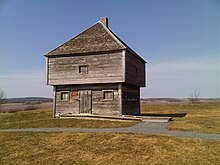| New Scotland ((in)Nova Scotia (gd)Alba Nuadh) | |
 | |
| Lunenburg, a village in Nova Scotia and a site in Unesco World Heritage | |
| Information | |
| Country | |
|---|---|
| Region | Maritime provinces |
| Regional capital | Halifax |
| Area | 55 283 km² |
| Population | 935 962 hab. (2008) |
| Density | 16,93 inhab./km² |
| Postal code | B |
| Spindle | Atlantic Time, America / Halifax, America / Glace Bay |
| Location | |
 45 ° 0 ′ 0 ″ N 63 ° 0 ′ 0 ″ W | |
| Official site | |
| Touristic site | |
The New Scotland is one of maritime provinces of Canada in the east of the country.
Understand
Nova Scotia is the second smallest province in Canada after'Prince Edward Island. It is mainly composed by a peninsula surrounded by theAtlantic Ocean. Indeed, there is no place in Nova Scotia that is more than 67 km of the ocean. The province includesCape Breton Island in the northeast of the mainland of the province. It also includes theSable Island, a small island known for its wrecks, located at 175 km off the southern coast of the province.
The population of Nova Scotia, although less than one million, is very diverse: Mi'kmaq, descendants scots, the Acadians, the farmers of the annapolis valley, the inhabitants of Cape Breton and the Haligonians forming distinct groups with their own culture and language. For example, the novel Rockbound is written entirely in the dialect of the fishermen of the South side, a mixture ofEnglish, ofGerman and local idioms.
The name of the province in English is Nova Scotia, which is Nova Scotia in Latin, not “New Scotland”.
History

The place was first named Acadia by Samuel de Champlain and claimed on behalf of the France in 1604. French immigrants settled there to become fishermen and farmers. They were expelled by the British in the XVIIIe century and their lands were occupied mainly by "Forgein Protestants "(Foreign Protestants) from the Netherlands and D'Germany who were invited to settle there to replace the Catholic Acadians. Nonetheless, many places in Nova Scotia still have a vibrant Acadian culture. Nova Scotia was also the host of the World Acadian Congress in 2005. The poem Evangeline written by Longellow tells the story of the Acadian deportation. The Acadians of Nova Scotia were notably deported to the Louisiana and the New Brunswick.
The provincial capital, Halifax, is one of the oldest cities in North America and served as an important port in both world wars. The explosion caused by two colliding ships in Halifax Harbor in 1917 was the worst man-made explosion until Hiroshima in 1945.
Weather
Nova Scotia has a temperate climate. Although she is surrounded by theAtlantic Ocean, it has a more continental than maritime climate. Temperature extremes are nevertheless moderated by the ocean. Unless you are a winter sports enthusiast, it is best to visit Nova Scotia between June and October when the temperature is warmer, the sky is blue and the water less icy.
Holidays and public holidays
In addition to national holidays from Canada, the first Monday in August is Foundation Day in Nova Scotia to celebrate the province's birthday.
Regions
 The regions, main cities and other destinations of Nova Scotia |
|
Cities
- Guysborough
- Halifax – The provincial capital.
- Hubley
- Lunenburg
- Middleton
- New Glasgow
- Pictou
- Sydney
- Windsor
- Yarmouth
Other destinations
To go
By bus
There are two intercity bus companies providing interprovincial service to Nova Scotia: Greyhound Canada and Maritime Bus. However, it should be noted that their routes only follow the Trans-Canada Highway and the corridor between Truro and Halifax and do not travel elsewhere in the province.
By plane
The main airport in the province is Robert L. Stanfield International Airport (IATA : YHZ) from Halifax. There are also direct scheduled flights to J.A. Douglas McCurdey Airport from Sydney (IATA : YQY) from Halifax as well as scheduled flights from Boston, Toronto and other cities of maritime provinces.
On a boat
There is a ferry (ferry) connecting Pictou and Digby at Saint Jean at New Brunswick. There is also a ferry connecting North Sydney at Newfoundland and another connecting Yarmouth at Portland at Maine.
By train
VIA Rail offers a passenger train service connecting Halifax at Montreal at Quebec three times per week. The journey takes approximately 22 h. There are also stops at Truro and Amherst.
By car
The Trans-Canada Highway connect the New Brunswick at Amherst. It is a journey of approximately 3 h route from Moncton in New Brunswick and 3 h 30 from Charlottetown on thePrince Edward Island to join Halifax.
Circulate
Itineraries
Speak
Buy
A 15% Harmonized Sales Tax (HST) applies on the majority of goods and services purchased in Nova Scotia.
